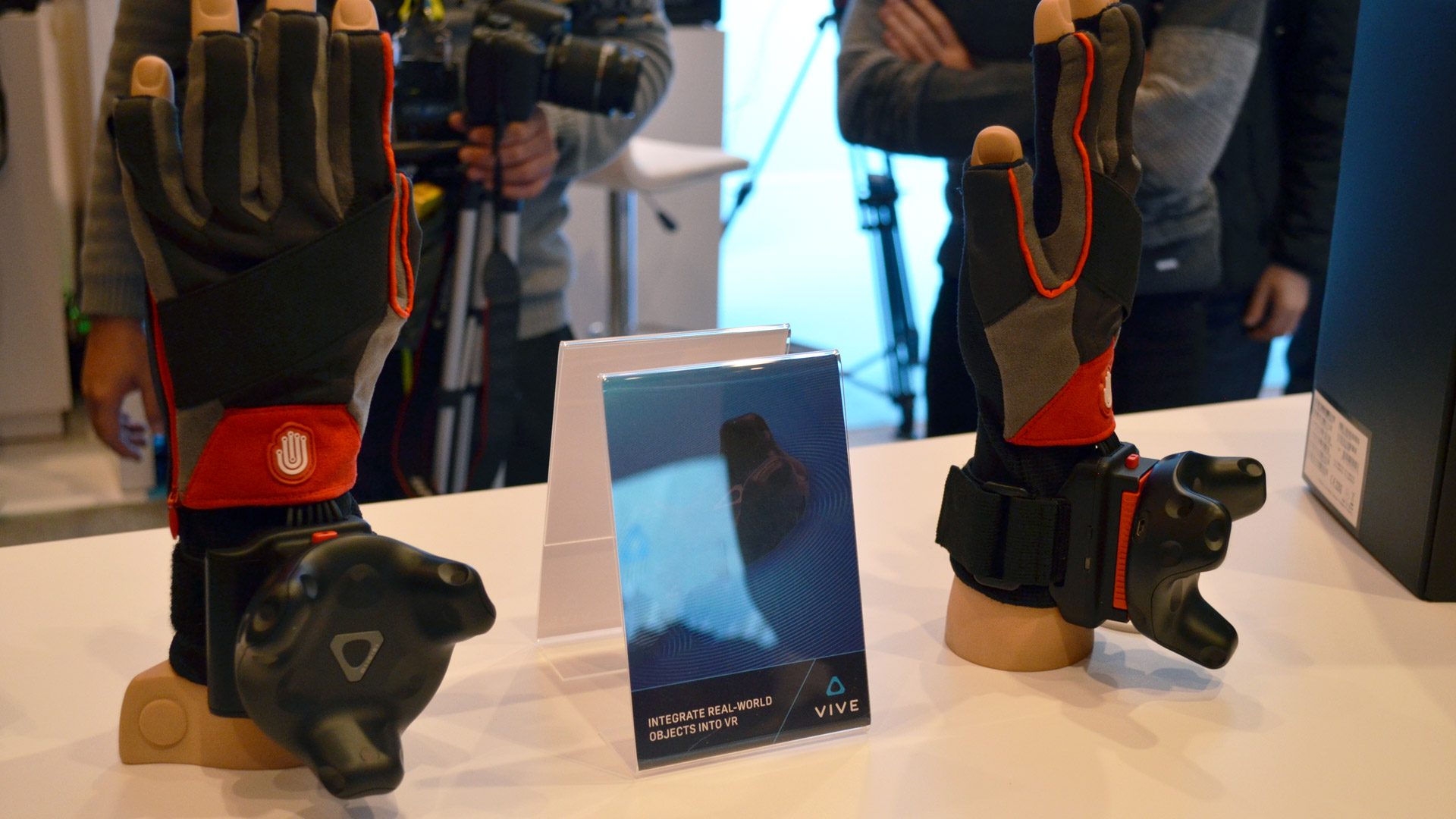VR input gloves are getting a big boost thanks to HTC’s newly revealed Vive Tracker. The combination of Noitom’s Hi5 VR glove and the Tracker forms a surprisingly compelling input experience that adds finger-level fidelity to Vive experiences.
We’ve seen plenty of VR gloves and other finger-tracking input methods over the years, and while a few of them proved quite functional, most had one flaw standing in the way of adoption. Usually that flaw was the tracking system, which was either not good enough or was a complex third-party approach which made the system unlikely to be adoptable for consumer use because of setup times and the difficulties with mixing and matching tracking technologies. The Vive Tracker, it seems, is about to change all of that.
Thanks to the Tracker, it’s become easy to precisely track third-party accessories in the same coordinate plane, with the same accuracy, and with the same latency as the VR headset itself, eliminating a host of issues in one fell swoop.
Functional and Practical

![]()
One of the advantages of the Noitom Hi5 is the quick setup time. Unlike some other glove systems we’ve seen which also require bicep and even chest straps, the Hi5 is just the glove. Pull it on, synch the wrist strap and you’re good to go.
One thing I was initially concerned about was that the wrist-mounted Vive Tracker would wobble around and cause my virtual hand to wobble even when my real hand did not. Fortunately I found that the Tracker sat on my wrist close enough to the hand that the two were always rotationally in sync, and I was able to tighten the strap enough to prevent any wobbling.
Hands and Fingers Together
With the gloves and headset on, I immediately saw the responsive hand tracking provided by the Tracker, which taps into the same SteamVR Tracking tech as the headset. Beyond just hand-tracking, each of my fingers were individually tracked, offering full range of vertical movement. Horizontal finger movements didn’t appear to be tracked, through the use-cases for that sort of movement seem extremely slim.
With the Noitom Hi5 gloves, I felt able to fully articulate my hand in the virtual world, including giving thumbs up, pointing, and a certain lewd gesture with ease. Pointing, in particular, worked well enough that it became a more precise way to activate virtual buttons to make various selections. I was also able to gently tap a row of dominos with a satisfyingly precise flick of a finger.
A Challenge Remains
Initiating a “grab” with VR gloves is still a bit of an issue. Pinch gestures are sometimes employed to make it clear to the computer when you do or don’t intend to be grasping a virtual object, but using a pinch to pick up objects often feels unnatural. Some gloves use a “mock” grab gesture where you basically close your hand part way and pretend to be grabbing a real object when there isn’t actually one in your hands. This too feels awkward. Without the feedback of a real object to grip, the virtual grabbing interaction feels unsatisfying. Controllers, oddly enough, usually feel much more natural for virtual grabbing functionality because you have the feedback of something in your hand as you are grabbing the object.
For now, the Hi5’s ‘grab detection’ felt relatively good, but still gave me some trouble. The computer isn’t always clear when you want to be holding an object and when you want to let it go. This meant I had a number of instances where I wanted to throw an object but it was left stuck to my hand until the next try. That might not seem like a big deal when the object is a ping pong ball, but when you’re in the middle of a competition VR multiplayer match and you go to throw that virtual grenade, only to find it stuck to your hand after you went to throw it… you’re going to be cursing the glove. Input needs to be 99.9% (if not 100%) accurate otherwise it will frustrate the user to no end. I often say: imagine if your mouse was 90% accurate… how frustrated would you be if every 10th click simply didn’t work? You’d probably throw that mouse out and buy a new one.
The grabbing gesture can certainly be defined and improved in software, but even then, it’s been a persistent challenge for most finger-tracked systems to find an all-encompassing approach to grab detection that works consistently for all the ways different users might attempt to grab virtual objects. It could be said that a more explicit grabbing gesture could be taught to users (like making a fist for instance), but in my mind the purpose of the glove is largely defeated if the user needs to be taught how to grab or throw an object differently than they would in real life—after all, the whole point of bringing your fingers into the virtual world is to make the experience more natural, not less.
– – — – –
Save for the inconsistent grab detection—and questions surrounding the awkwardness of pretending to grab something when there’s nothing actually in your hands—the Hi5 glove felt responsive and definitely make interactions with small physical objects in the virtual world more compelling. The addition of real finger pointing also opens the door to more nuanced interface input.
With some tweaks, Noitom has something pretty cool on their hands here. Now that we know it works, the next question is price. The company hasn’t announced pricing yet, but says the glove is being positioned for the consumer market on the way to its Spring 2017 launch.

